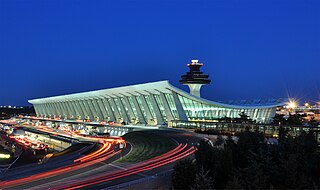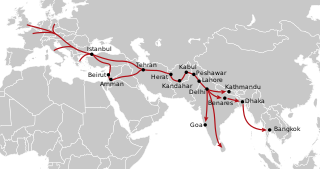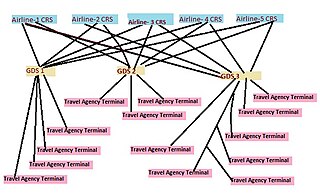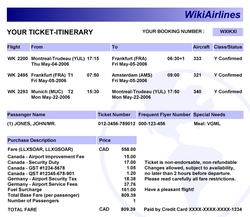
Washington Dulles International Airport is an international airport in Loudoun County and Fairfax County in Northern Virginia, United States, 26 miles (42 km) west of downtown Washington, D.C.

Western Airlines was a major airline in the United States based in California, operating in the Western United States including Alaska and Hawaii, and western Canada, as well as to New York City, Boston, Washington, D.C., and Miami and to Mexico City, London and Nassau. Western had hubs at Los Angeles International Airport, Salt Lake City International Airport, and the former Stapleton International Airport in Denver. Before it merged with Delta Air Lines in 1987 it was headquartered at Los Angeles International Airport (LAX). Throughout the company's history, its slogan was "Western Airlines...The Only Way to Fly!"

Hippie trail is the name given to an overland journey taken by members of the hippie subculture and others from the mid-1950s to the late 1970s travelling from Europe and West Asia through South Asia via countries such as Afghanistan, Pakistan, India, Nepal, Sri Lanka, Bangladesh to Thailand. The hippie trail was a form of alternative tourism, and one of the key elements was travelling as cheaply as possible, mainly to extend the length of time away from home. The term "hippie" became current in the mid-to-late 1960s; "beatnik" was the previous term from the later 1950s.

San Francisco International Airport is the primary international airport serving the San Francisco Bay Area in the U.S. state of California. It is located in an unincorporated area of San Mateo County.

San Francisco Bay Oakland International Airport is an international airport in Oakland, California. The airport is located 7 miles (11 km) south of Downtown Oakland and 12 miles (19 km) east of San Francisco, serving the East Bay of the San Francisco Bay Area. The airport is owned by the Port of Oakland and has domestic passenger flights to cities throughout the United States and international flights to Mexico, El Salvador, and Portugal, in addition to cargo flights to China and Japan. The airport covers 2,600 acres (1,100 ha) of land. The airport is an operating base for Southwest Airlines, which operates point-to-point routes with bases instead of a traditional network with hubs.

Philadelphia International Airport is the primary international airport serving Philadelphia, Pennsylvania, United States. It served 12.4 million passengers annually in 2022, making it the busiest airport in Pennsylvania and the 21st-busiest airport in the United States. The airport is located 7 miles (11 km) from the city's downtown area and has 22 airlines that offer nearly 500 daily departures to more than 130 destinations worldwide.

A low-cost carrier (LCC) or low-cost airline, also called a budget, or discount carrier or airline, is an airline that is operated with an emphasis on minimizing operating costs. It sacrifices certain traditional airline luxuries for cheaper fares. To make up for revenue lost in decreased ticket prices, the airline may charge extra fees, such as for carry-on baggage. As of April 2020, the world's largest low-cost carrier is Southwest Airlines, which operates primarily in the United States, as well as in some surrounding areas.

In commercial aviation, a red-eye flight refers to a flight that departs at night and arrives the next morning, especially when the total flight time is insufficient for passengers to get a full night's sleep.

An airline hub or hub airport is an airport used by one or more airlines to concentrate passenger traffic and flight operations. Hubs serve as transfer points to help get passengers to their final destination. It is part of the hub-and-spoke system. An airline may operate flights from several non-hub (spoke) cities to the hub airport, and passengers traveling between spoke cities connect through the hub. This paradigm creates economies of scale that allow an airline to serve city-pairs that could otherwise not be economically served on a non-stop basis. This system contrasts with the point-to-point model, in which there are no hubs and nonstop flights are instead offered between spoke cities. Hub airports also serve origin and destination (O&D) traffic.

A round-the-world ticket is a product that enables a traveller to circumnavigate the world on a single itinerary. RTW tickets in the past were generally offered through marketing agreements between airlines on several continents. Now, they are generally offered by airline alliances such as SkyTeam, Star Alliance and Oneworld, or by specialist travel agencies that will plan a custom trip for the consumer. Prices vary but are generally in the range of US$2,500–6,000 for an economy class ticket and US$5,000–14,000 for business class. An alternative for a round-the-world ticket is a continent pass.
Airline booking ploys are used by travelers in commercial aviation to lower the price of flying by circumventing airlines' rules about how tickets may be used. They are generally a breach of the contract of carriage between the passenger and the airline, which airlines may try to enforce in various ways.

Point-to-point transit is a transportation system in which a plane, bus, or train travels directly to a destination, rather than going through a central hub. This differs from the spoke-hub distribution paradigm in which the transportation goes to a central location where passengers change to another train, bus, or plane to reach their destination.

A global distribution system (GDS) is a computerised network system owned or operated by a company that enables transactions between travel industry service providers, mainly airlines, hotels, car rental companies, and travel agencies. The GDS mainly uses real-time inventory from the service providers. Travel agencies traditionally relied on GDS for services, products and rates in order to provide travel-related services to the end consumers. Thus, a GDS can link services, rates and bookings consolidating products and services across all three travel sectors: i.e., airline reservations, hotel reservations, car rentals.

An airline ticket is a document or electronic record, issued by an airline or a travel agency, that confirms that an individual is entitled to a seat on a flight on an aircraft. The airline ticket may be one of two types: a paper ticket, which comprises coupons or vouchers; and an electronic ticket.
Fare avoidance, as distinct from fare evasion, is the lawful use of knowledge to travel using tickets which cost significantly less than the 'normal' fare for a given journey, which is what one might be expected to use. It is common in some parts of the world with complex travel networks, notably the National Rail network of Great Britain.

A train ticket is a transit pass ticket issued by a railwayoperator that enables the bearer to travel on the operator's network or a partner's network. Tickets can authorize the bearer to travel a set itinerary at a specific time, a set itinerary at any time, a set itinerary at multiple times, or an arbitrary itinerary at specific times. The last two categories are often called passes: the former is often sold as a discounted block of trips for commuters; the latter is often sold to vacationers, such as European Eurail passes.

San Francisco and Oakland Helicopter Airlines was a helicopter airline service offering scheduled passenger flights between San Francisco, Oakland, and other Bay Area cities. It was founded in 1961 but disappeared from the Official Airline Guide 15 years later before finally going out of business in 1986.
Norwegian Long Haul AS was a division of Norwegian Air Shuttle that operated long-haul flights between Europe, Asia, and North America with an all-Boeing 787 Dreamliner fleet.
A travel itinerary is a schedule of events relating to planned travel, generally including destinations to be visited at specified times and means of transportation to move between those destinations. For example, both the plan of a business trip and the route of a road trip, or the proposed outline of one, are travel itineraries.
In commercial aviation, a city pair is defined as a pair of departure (origin) and arrival (destination) airport codes on a flight itinerary. A given city pair may be a single non-stop flight segment, a direct flight with one or more stops, or an itinerary with connecting flights. The city pair, IAD-LHR would consist of flights and/or multi-leg itineraries that originate at Washington-Dulles Airport and terminate at London Heathrow Airport. The city pair, NYC-TYO would consist of flights and/or multi-leg itineraries that originate at any New York airport and terminate at either Narita or Haneda in Tokyo.















